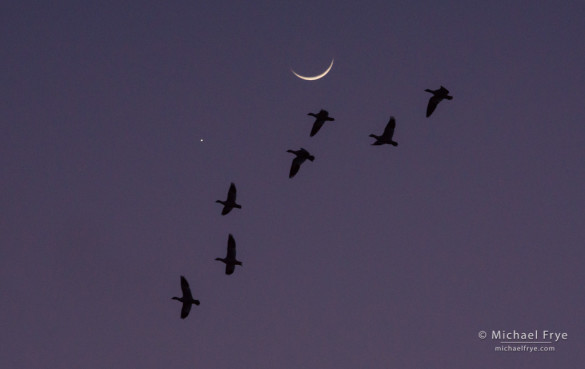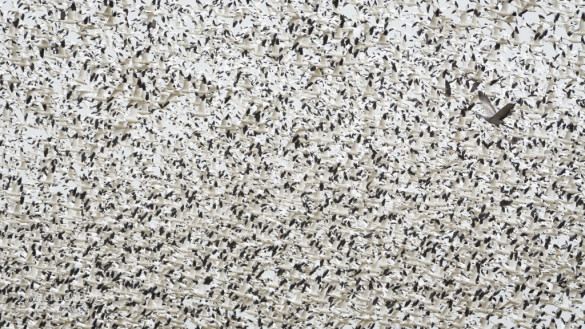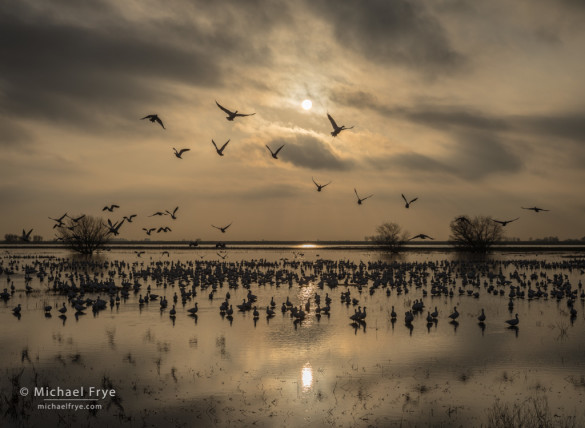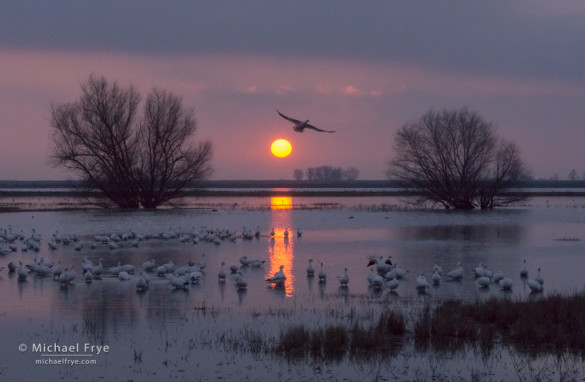I’ve been working on a book deadline, so haven’t been able to get to Yosemite Valley and check on Horsetail Fall recently. But I did break away from the desk on Friday to go down to the Central Valley and photograph birds. At first the light was rather uninspiring, because the fog I was hoping for had lifted into a low overcast. But it turned out to be a great day. I photographed one of the biggest goose takeoffs I’ve ever seen, with perhaps 30,000 birds lifting off at once; one of the photographs below shows part of that group. Later, the sun broke through the stratus deck to create some beautiful sunbeams, and at dusk Venus and the crescent moon appeared (above).
As for Horsetail, the flow diminished quickly after the last rainstorm, and from reports I’ve heard there is basically no water in it – just a bit of dampness. There is another storm predicted for today and tomorrow. This is expected to be both colder and weaker than the last storm, with snow levels around 6,000 feet, but limited moisture. Horsetail might get some help from this system, but probably not much. Even if this storm turns out to be bigger than predicted, any precipitation in Horsetail’s drainage will fall as snow, so there won’t be a significant boost in flow until the sun comes out and melts some of that snow. It’s supposed to be sunny Tuesday, Wednesday, and Thursday, so maybe by Wednesday or Thursday we could see a decent water flow in Horsetail.
Of course the window of best light for Horsetail is coming to a close. I’ve said that the window is from February 16th through 23rd, but it’s not like the light is great on the 23rd, and terrible on the 24th. By March 1st the light gets cut off by the Nose of El Capitan before the color reaches maximum intensity, so Horsetail can turn gold, but not orange or red. In between now and March 1st there will be a gradual decline in the color intensity. I think the light can still be good this week, if there’s water – but that’s a big if.
— Michael Frye
Related Posts: Subject, Meet Light; Will the Approaching Storm Revive Horsetail Fall?; After the Storm; The Best Time to Photograph Horsetail Fall, Revised
Did you like this article? Click here to subscribe to this blog and get every new post delivered right to your inbox!
Michael Frye is a professional photographer specializing in landscapes and nature. He is the author or principal photographer of The Photographer’s Guide to Yosemite, Yosemite Meditations, Yosemite Meditations for Women, Yosemite Meditations for Adventurers, and Digital Landscape Photography: In the Footsteps of Ansel Adams and the Great Masters. He has also written three eBooks: Light & Land: Landscapes in the Digital Darkroom, Exposure for Outdoor Photography, and Landscapes in Lightroom 5: The Essential Step-by-Step Guide. Michael has written numerous magazine articles on the art and technique of photography, and his images have been published in over thirty countries around the world. Michael has lived either in or near Yosemite National Park since 1983, currently residing just outside the park in Mariposa, California.













Michael:
Thanks for the update on Horsetail. I was up a couple times this month hoping to get a nice shot, but it looks like it will need to wait until next year.
You’re welcome Mitchell; better luck next year!
Wonderful captures, Michael!
You were off in the goose count in the first scene – I only counted 29,892 in your frame. 🙂
Gorgeous light and compositions on the dusk/sunset shots.
Thanks Chuck, and you have pretty good eyes to be able to count all those birds from a small JPEG! 🙂 This frame includes only part of the flock, perhaps 5,000 birds. Still a lot of geese in one picture.
That Ross’s and Sandhill shot is awesome, Michael! I’d sure like to see that one large!
Thanks Jackson!
Great stuff, as usual, Michael!
Dan
Thanks Dan!
Wow, what a flock of birds! Great shot, Michael.
Thank you Robin!
Aww the poor Sandhill crane!! His name must be Waldo. Wonderful image!
Well the crane had many friends just out of the frame, so don’t feel sorry for him (or her). 🙂
Hey Michael,
Beautiful images, as always. Your Ross’s Geese blastoff with single Sandhill is the most spectacular version of this genre I remember seeing. WOW?? … and congrats!
Thanks very much Brent!
I was up at Horsetail Thursday and Friday. The light was perfect, with a little bit of haze in the air to add to the drama. Unfortunately, as you reported, the falls were dry, with just a little bit of moisture on the rocks. Still, it was beautiful and I look forward to trying again next year.
Thanks for the report Marta. Unfortunately, Yosemite Valley hasn’t received any measurable precipitation from this latest weather system, so it doesn’t look like the flow will increase anytime soon.
Oh my, all those geese! It must’ve been quite the spectacle to see in person. I like that there is one lone sandhill crane. Instead of just seeing a mass of birds, that little bit of difference is enough to hold that attention and make one realize just how many geese there must be.
Thanks Vivienne!
We too spent the weekend (March 20-23) in Yosemite hoping to catch Horsetail on fire. Of course it was but a mere trickle but the valley in late winter is spectacular. I enjoyed beautiful pre-sunrise walks at swinging bridge and in the meadows with deer, a coyote and a beaver! So glad we went despite missing the glowing fall. Thanks for sharing your pics, info and knowledge!
You’re welcome Elizabeth, and I’m glad you enjoyed your trip to Yosemite. Horsetail or not, it’s always beautiful.
Great photos Michael! One of these days I will see a group take-off like that! Amazing! I’ve been out a couple of times this week to Merced. There are still a lot of geese but they’re pretty spread out and leave around 4pm to 5pm in smaller numbers. I guess they know that hunting season is over! Here’s one of the shots I’ve gotten of them in the past few days, the light has been nice. http://www.douglascroftimages.com/Flora-Fauna/i-Dvtpb8d/A I’m done with them till next winter, now on to the gray whale migration past Big Sur!
Thanks Doug! Nice photo, and interesting that you managed to photograph a group of snow geese at a refuge where almost all the geese are Ross’s geese. Good luck with the whales!
D’oh! I thought I’d finally figured out how to tell them apart. Thanks for the correction!
Yeah, they are tough to tell apart! But the longer, skinnier necks, longer beaks, and rusty heads definitely make them snow geese.
You should make your way to Big Sur last week of April/First week of May. The Lupine should be covering the hills and the migration is in full swing with the cows and calves passing directly beneath the cliffs. It is an amazing time be be over here. I’d be happy to show you some of the hot spots.
Thanks for the suggestion Doug! That’s a busy time of year for me, but if I get a chance I might head down that way.
Michael, The lupines made an early and unspectacular appearance this year but the whale migration is in full swing! Here’s a link to a couple of examples that I shot early this week.
http://www.douglascroftimages.com/Recent-Additions/
Nice Doug – I like the combination of whales and kelp.